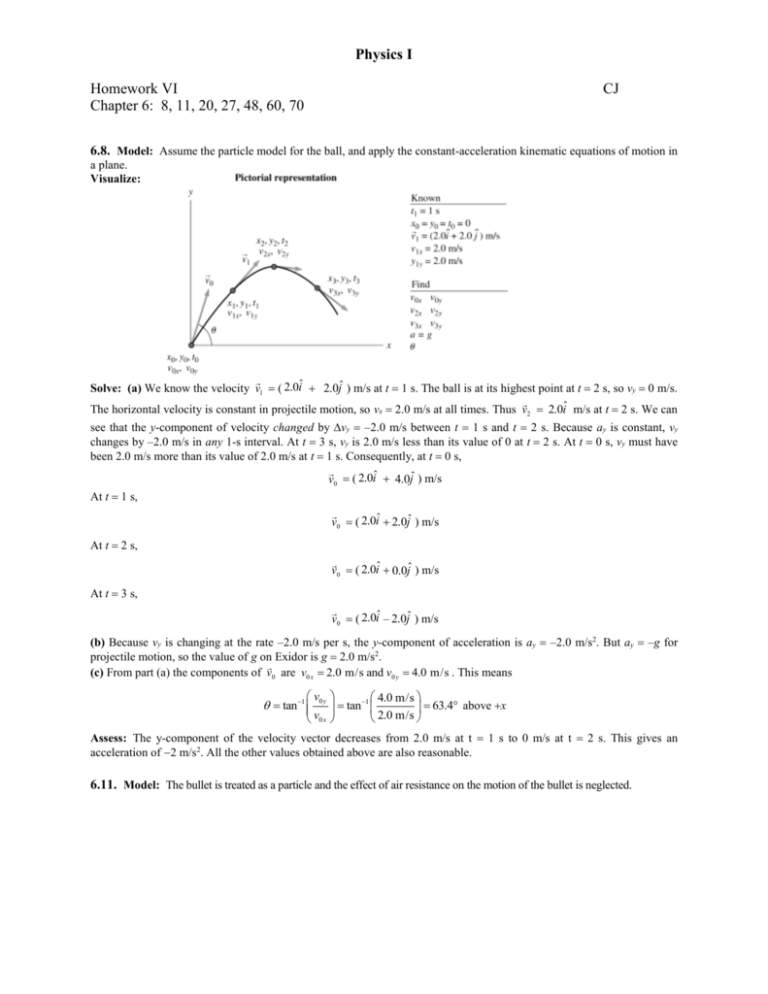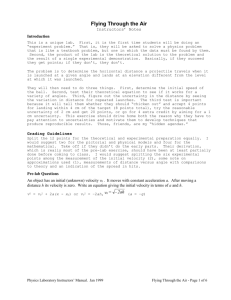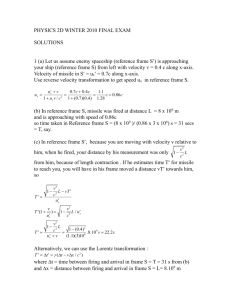KEY - Rose
advertisement

Physics I Homework VI Chapter 6: 8, 11, 20, 27, 48, 60, 70 CJ 6.8. Model: Assume the particle model for the ball, and apply the constant-acceleration kinematic equations of motion in a plane. Visualize: Solve: (a) We know the velocity v1 ( 2.0iˆ 2.0jˆ ) m/s at t 1 s. The ball is at its highest point at t 2 s, so vy 0 m/s. The horizontal velocity is constant in projectile motion, so vx 2.0 m/s at all times. Thus v 2.0iˆ m/s at t 2 s. We can 2 see that the y-component of velocity changed by vy –2.0 m/s between t 1 s and t 2 s. Because ay is constant, vy changes by –2.0 m/s in any 1-s interval. At t 3 s, vy is 2.0 m/s less than its value of 0 at t 2 s. At t 0 s, vy must have been 2.0 m/s more than its value of 2.0 m/s at t 1 s. Consequently, at t 0 s, v0 ( 2.0iˆ 4.0jˆ ) m/s At t 1 s, v0 ( 2.0iˆ 2.0jˆ ) m/s At t 2 s, v0 ( 2.0iˆ 0.0jˆ ) m/s At t 3 s, v0 ( 2.0iˆ – 2.0jˆ ) m/s (b) Because vy is changing at the rate –2.0 m/s per s, the y-component of acceleration is ay –2.0 m/s2. But ay –g for projectile motion, so the value of g on Exidor is g 2.0 m/s2. (c) From part (a) the components of v0 are v0 x 2.0 m/s and v0 y 4.0 m/s . This means v0 y 1 4.0 m/s tan 63.4 above x 2.0 m/s v0 x tan1 Assess: The y-component of the velocity vector decreases from 2.0 m/s at t 1 s to 0 m/s at t 2 s. This gives an acceleration of 2 m/s2. All the other values obtained above are also reasonable. 6.11. Model: The bullet is treated as a particle and the effect of air resistance on the motion of the bullet is neglected. Visualize: Solve: (a) Using y1 y0 v0 y t1 t0 21 ay t1 t0 , we obtain 2 2.0 10 2 m 0 m 0 m 21 9.8 m/s2 t1 0 s t1 0.0639 s 2 (b) Using x1 x0 v0 x t1 t0 21 ax t1 t0 , 2 50 m 0 m v0 x 0.0639 s 0 s 0 m v0 x 782 m/s Assess: The bullet falls 2 cm during a horizontal displacement of 50 m. This implies a large initial velocity, and a value of 782 m/s is understandable. 6.20. Model: Assume the particle model for the rocket-powered hockey puck and use the constant-acceleration kinematic equations. Solve: (a) The force and acceleration of the hockey puck are F F cos iˆ F sin ˆj ma a F cos ˆ F sin ˆ i j m m From kinematics: x x0 v0 x t t0 21 ax t t0 0 m 0 m 21 ax t 2 21 ax t 2 2 y y0 v0 y t t0 21 ay t t0 0 m v0t 21 ayt 2 v0t 21 ayt 2 2 From the x-equation t 2x ax . Substituting this into the y-equation, we get y v0 2x 1 2x 2 mx ay v0 x tan ax 2 ax F cos (b) Substituting the known values into the expression from part (a), y 2.0 m/s 2 1.0 kg x 2.0 N cos45 x tan45 2.38 m/s when 45 and when x and y are in meters. The equation for –45 is y 2.38 m/s x x x x 6.27. Model: The golf ball is a particle following projectile motion. Visualize: (a) The distance traveled is x1 v0xt1 v0 cos t1. The flight time is found from the y-equation, using the fact that the ball starts and ends at y 0: y1 y0 0 v0 sin t1 21 gt12 (v0 sin 21 gt1 ) t1 t1 2v0 sin g Thus the distance traveled is x1 v0 cos 2v0 sin 2v02sin cos g g For 30°, the distances are ( x1 )earth 2v02sin cos 2(25 m/s) 2sin30cos30 55.2 m gearth 9.80 m/s2 ( x1 )moon 2v02sin cos 2v02sin cos 2v02sin cos 6 6( x1 )earth 331.2 m 1 gmoon gearth 6 gearth The golf ball travels 331.2 m – 55.2 m 276 m farther on the moon than on earth. (b) The flight times are (t1 )earth 2v0 sin 2.55 s gearth (t1 )moon 2v0 sin 2v0 sin 1 6(t1 )earth 15.30 s gmoon g 6 earth The ball spends 15.30 s – 2.55 s 12.75 s longer in flight on the moon. 6.48. Model: The model rocket is treated as a particle and its motion is determined by constant-acceleration kinematic equations. Visualize: Solve: As the rocket is accidentally bumped v0 x 0.5 m/s and v0 y 0 m/s . On the other hand, when the engine is fired Fx max ax Fx 20 N 40 m/s2 m 0.5 kg (a) Using y1 y0 v0 y t1 t0 21 ay t1 t0 , 2 0 m 40 m 0 m 1 2 9.8 m/s t 2 2 1 t1 2.857 s The distance from the base of the wall is x1 x0 v0 x t1 t0 21 ax t1 t0 0 m 0.5 m/s 2.857s 21 40 m/s2 2.857 s 165 m 2 2 (b) The x- and y-equations are y y0 v0 y t t0 21 ay t t0 40 4.9t 2 2 x x0 v0 x t t0 21 ax t t0 0.5t 20t 2 2 Except for a brief interval at t 0, 20t2 >> 0.5t. Thus x 20t 2 , or t2 x/20. Substituting this into the y-equation gives y 40 – 0.245x This is the equation of a straight line, so the rocket follows a linear trajectory to the ground. 6.60. Model: Let the ground frame be S and the car frame be S. S moves relative to S with a velocity V along the xdirection. Solve: The Galilean transformation of velocity is v v V where v and v are the velocities of the raindrops in frames S and S. While driving north, V 25 m/s iˆ and v v cos ˆj v sin iˆ . Thus, R R v v V vR sin 25 m/s iˆ vR cos ˆj Since the observer in the car finds the raindrops making an angle of 38 with the vertical, we have vR sin 25 m/s tan38 vR cos While driving south, V 25 m/s iˆ , and v vR cos ˆj vR sin iˆ . Thus, v vR sin 25 m/s iˆ vR cos ˆj Since the observer in the car finds the raindrops falling vertically straight, we have vR sin 25 m/s tan0 0 vR sin 25 m/s vR cos Substituting this value of vR sin into the expression obtained for driving north yields: 25 m/s 25 m/s 50 m/s tan38 vR cos 64.0 m/s vR cos tan38 Therefore, we have for the velocity of the raindrops: vR sin vR cos 25 m/s 64.0 m/s 2 2 2 tan 2 vR2 4721 m/s vR 68.7 m/s 2 vR sin 25 m/s 21.3 v R cos 64 m/s The raindrops fall at 68.7 m/s while making an angle of 21.3 with the vertical. 6.70. Model: The airplanes are modeled as particles, and are undergoing relative motion according to the Galilean transformations of position and velocity. We designate Uri’s plane as frame S and the earth as frame S. Frame S moves relative to frame S with velocity V . Visualize: Solve: According to the Galilean transformation of velocity v v V , where v is the velocity of Val’s plane relative to the Earth, v is the velocity of Val’s plane relative to Uri’s plane, and V is the velocity of Uri’s plane relative to the earth. We have v 500 mph cos30iˆ 500 mph sin30 ˆj V 500 mph cos20iˆ 500 mph sin20 ˆj v v V 36.8 mph iˆ 421 mph ˆj 421 85 36.8 tan1 The fuselage of Val’s plane points 30 north of west. Val sees her plane moving in a direction 85 north of east. Thus the angle between the fuselage and the direction of motion is 180 30 85 65








